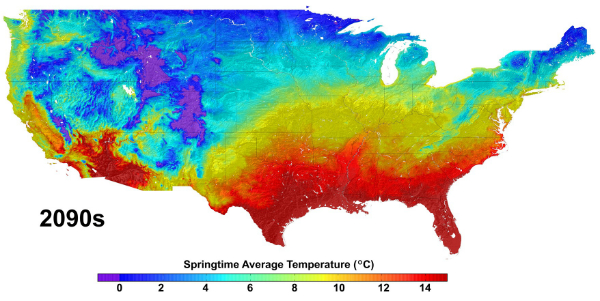
Climate change projections for the United States, such as the data shown in this image of average springtime temperature change from the 1950s to the 2090s, will be available on the cloud through an agreement with Amazon Web Services. This data was produced by the NASA Earth Exchange (NEX), a research platform of the NASA Advanced Supercomputer Facility at the agency’s Ames Research Center in Moffett Field, Calif.
NASA and Amazon Web Services Inc. (AWS) of Seattle, Wash., are making a large collection of NASA climate and Earth science satellite data available to research and educational users through the AWS cloud.
The system enhances research and educational opportunities for the U.S. geoscience community by promoting community-driven research, innovation and collaboration.
“NASA continues to support and provide open public access to research data, and this collaboration is entirely consistent with that objective,” said NASA Chief Scientist Ellen Stofan at the agency’s headquarters in Washington. “Earth science research is important to every person on the planet, and we welcome contributions from all researchers in improving our understanding of Earth and its climate.”
This agreement allows NASA and AWS to experiment with a new way to provide data services. By using the cloud, research and application users worldwide gain access to an integrated Earth science computational and data management system they can use on their own.
The service encompasses selected NASA satellite and global change data sets — including temperature, precipitation, and forest cover — and data processing tools from the NASA Earth Exchange (NEX), a research platform of the NASA Advanced Supercomputer Facility at the agency’s Ames Research Center in Moffett Field, Calif.
“We are excited to grow an ecosystem of researchers and developers who can help us solve important environmental research problems,” said Rama Nemani, principal scientist for the NEX project at Ames. “Our goal is that people can easily gain access to and use a multitude of data analysis services quickly through AWS to add knowledge and open source tools for others’ benefit.”
NEX is a collaboration and analytical platform that combines state-of-the-art supercomputing, Earth system modeling, workflow management and NASA remote-sensing data. Through NEX, users can explore and analyze large Earth science data sets, run and share modeling algorithms, collaborate on new or existing projects and exchange workflows and results within and among other science communities.
NASA has uploaded terabytes of data from three satellite and computer modeling datasets to the AWS platform and will upload more in the future. One data set, the NEX downscaled climate simulations, provides high-resolution climate change projections for the 48 contiguous U.S. states. The second data set, provided by the Moderate Resolution Imaging Spectroradiometer (MODIS) instrument on NASA’s Terra and Aqua satellites, offers a global view of Earth’s surface every 1 to 2 days. Finally, the Landsat data record from the U.S. Geological Survey provides the longest existing continuous space-based record of Earth’s land.
NASA climate data sets provided to AWS will continue to be available to the public in a full and open manner. The effort continues NASA’s adoption of cloud platforms to enhance digital services, enabling NASA to make more U.S. government data easy to find and access without having to download large amounts of data. In line with the Obama Administration’s Open Data Executive Order, this new collaboration encourages citizen entrepreneurs to create businesses, innovate, and conduct scientific research.
The NASA datasets will be available through the Amazon Public Data Sets program at:
http://aws.amazon.com/datasets
This website provides a centralized repository of selected public data sets that can be integrated into AWS cloud-based applications to reduce the time and cost associated with transferring large data sets.
“By bringing these NASA public data assets into the AWS cloud, we help NASA engage a larger community for global change impact modeling and analysis as well as data sciences innovation in general,” said Jamie Kinney, AWS senior manager for scientific computing. “Together, NASA and AWS are delivering faster time to science and taking the complexity out of accessing this important climate data.”
To learn more about the NASA NEX Public Data Sets on AWS, visit:
http://aws.amazon.com/nasa/nex
For information about NASA and agency programs, visit:
https://www.nasa.gov
-end-
Steve Cole
Headquarters, Washington
202-358-0918
stephen.e.cole@nasa.gov
Ruth Marlaire
Ames Research Center, Moffett Field, Calif.
650-604-4789
ruth.marlaire@nasa.gov
























